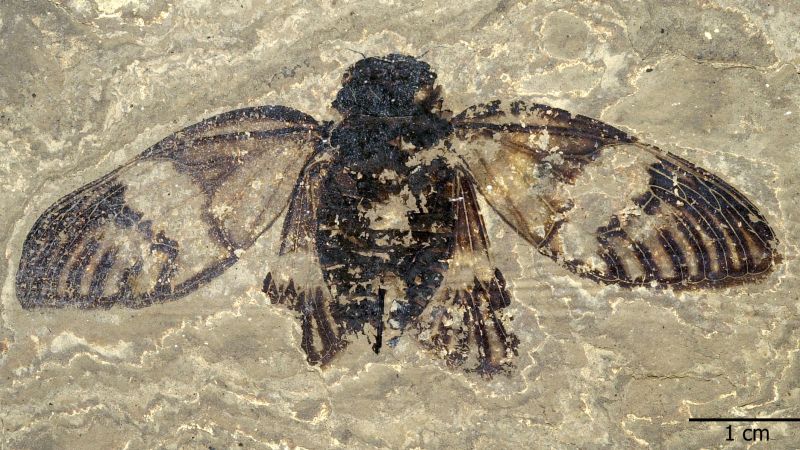In a remarkable discovery, scientists have unearthed a fossilized cicada, dating back approximately 47 million years, from Germany’s Messel Pit. This ancient insect, measuring about one inch (26.5 millimeters) in length and boasting a wingspan of 2.7 inches (68.2 millimeters), is almost flawlessly preserved, with its intricately veined wings spread wide. The find is significant as it represents not only the well-preserved remains of a past era, but also offers insights into the evolutionary history of cicadas.
The analysis of these fossils led to the identification of a new genus and species, named Eoplatypleura messelensis. Researchers utilized another fossil from the same era and location, also remarkably preserved, to understand its classification better. Despite both specimens being female, this discovery indicates that males of this species likely possessed the ability to produce sound, akin to modern cicadas. This finding challenges previous notions regarding the geographical spread of singing cicadas in Europe, suggesting they may have dispersed much earlier than previously thought.
Published in the journal *Scientific Reports* on April 29, the fossils of Eoplatypleura messelensis are now recognized as the oldest confirmed examples of “true” singing cicadas within the Cicadidae family. The modern cicadas we common recognize fall underneath this classification, including the annual varieties that emerge each summer and their periodical counterparts, which have life cycles spanning either 13 or 17 years. During this current year, Brood XIV, which encompasses one of the largest populations, is scheduled to emerge across numerous states in the United States.
Paleontologists have documented a mere 44 Cicadidae fossils throughout history, which signifies both the rarity of insect fossils and the specific conditions necessary for fossilization. The earliest recorded fossil of a singing cicada dates back between 59 and 56 million years ago, found in Montana. Dr. Hui Jiang, a paleontologist and lead author of the study from the Bonn Institute of Organismic Biology at the University of Bonn, emphasized the significance of this newly described European fossil, as it pushes the recorded existence of sound-producing cicadas back by approximately 20 million years.
Further examination of the fossil’s body structures allowed scientists to assign the ancient insect to an existing tribe called Platypleurini, primarily found in tropical and subtropical regions of sub-Saharan Africa and Asia. This data suggests that cicadas belonged to an evolutionary lineage that likely originated in Africa 30 to 25 million years ago, providing fresh insights into their dispersion and diversification.
Interestingly, the Messel pit, a UNESCO world heritage site since 1995, is renowned for its remarkable preservation conditions that have led to the recovery of diverse Eocene life forms, including Eoplatypleura messelensis. The area’s formation resulted from a volcanic lake that created conditions conducive for fossilization, making it a hotspot for paleontologists. Notably, this fossil is among one of the best-preserved insects from the site, showcasing the meticulous detail preserved in the fine-grain sediments.
Eoplatypleura messelensis exhibits a close resemblance to modern cicadas in overall body shape and coloration, which likely provided camouflage amidst natural environments. Yet, it diverges slightly in wing structure, with broader and less elongated forewings. This could have implications for flight dynamics and behavior.
While the exact sounds of E. messelensis remain a mystery, Dr. Jiang speculates it may have produced sounds with similar functions to its modern relatives. Furthermore, as cicadas such as Brood XIV prepare for their grand emergence in 2025, their calls—a cacophony reaching up to 100 decibels—will continue the cicada’s legacy of sound production that has echoed for millions of years. The volume of ancient cicada songs may even have been amplified due to anatomical features that suggest the potential for resonant sound production, a topic that future studies will aim to explore further, bridging ancient atmospheres with contemporary cicada biology.
Mindy Weisberger, a respected science writer with contributions to notable publications, brings this fascinating exploration of cicadas to light, enhancing our understanding of these insect champions of sound through millions of years of evolutionary history.












